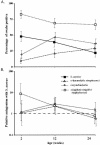Determinants of acquisition and carriage of Staphylococcus aureus in infancy
- PMID: 14662966
- PMCID: PMC308978
- DOI: 10.1128/JCM.41.12.5718-5725.2003
Determinants of acquisition and carriage of Staphylococcus aureus in infancy
Abstract
Nasal carriage of Staphylococcus aureus is a major risk factor for invasive S. aureus disease. The aim of this study was to define factors associated with carriage. We conducted a prospective, longitudinal community-based study of infants and their mothers for a period of 6 months following delivery. The epidemiology of carriage was examined for 100 infant-mother pairs. Infant carriage varied significantly with age, falling from 40 to 50% during the first 8 weeks to 21% by 6 months. Determinants of infant S. aureus carriage included maternal carriage, breastfeeding, and number of siblings. Bacterial typing of S. aureus was performed by pulsed-field gel electrophoresis and multilocus sequence typing. The majority of individuals carried a single strain of S. aureus over time, and the mother was the usual source for colonizing isolates in infants. The effect of other components of the normal nasal flora on the development of S. aureus carriage was examined in 157 consecutive infants. Negative associations (putative bacterial interference) between S. aureus and other species occurred early in infancy but were not sustained. An increasing antistaphylococcal effect observed over time was not attributable to bacterial interference. S. aureus carriage in infants is likely to be determined by a combination of host, environmental, and bacterial factors, but bacterial interference does not appear to be an ultimate determinant of carrier status.
Figures





References
-
- Boelaert, J. R., H. W. Van Landuyt, C. A. Godard, R. F. Daneels, M. L. Schurgers, E. G. Matthys, Y. A. De Baere, D. W. Gheyle, B. Z. Gordts, and L. A. Herwaldt. 1993. Nasal mupirocin ointment decreases the incidence of Staphylococcus aureus bacteraemias in haemodialysis patients. Nephrol. Dial. Transplant. 8:235-239. - PubMed
-
- Boris, M., H. R. Shinefield, P. Romano, D. P. McCarthy, and A. L. Florman. 1968. Bacterial interference. Protection against recurrent intrafamilial staphylococcal disease. Am. J. Dis. Child. 115:521-529. - PubMed
-
- de Silva, G. D., A. Justice, A. R. Wilkinson, J. Buttery, M. Herbert, N. P. Day, and S. J. Peacock. 2001. Genetic population structure of coagulase-negative staphylococci associated with carriage and disease in preterm infants. Clin. Infect. Dis. 33:1520-1528. - PubMed
Publication types
MeSH terms
LinkOut - more resources
Full Text Sources

